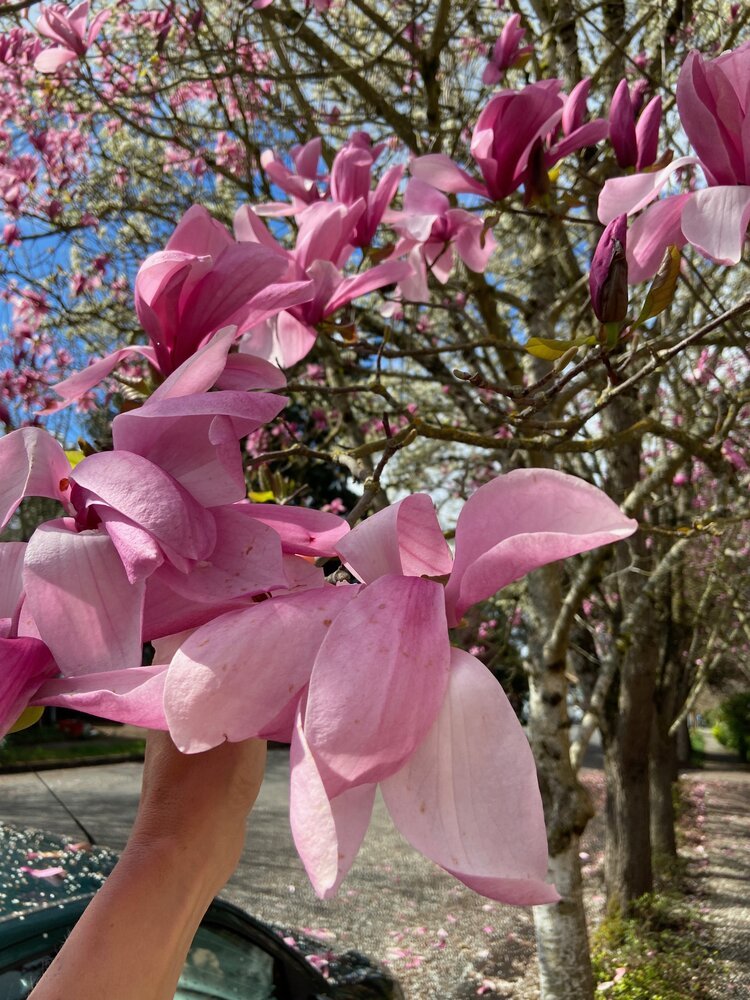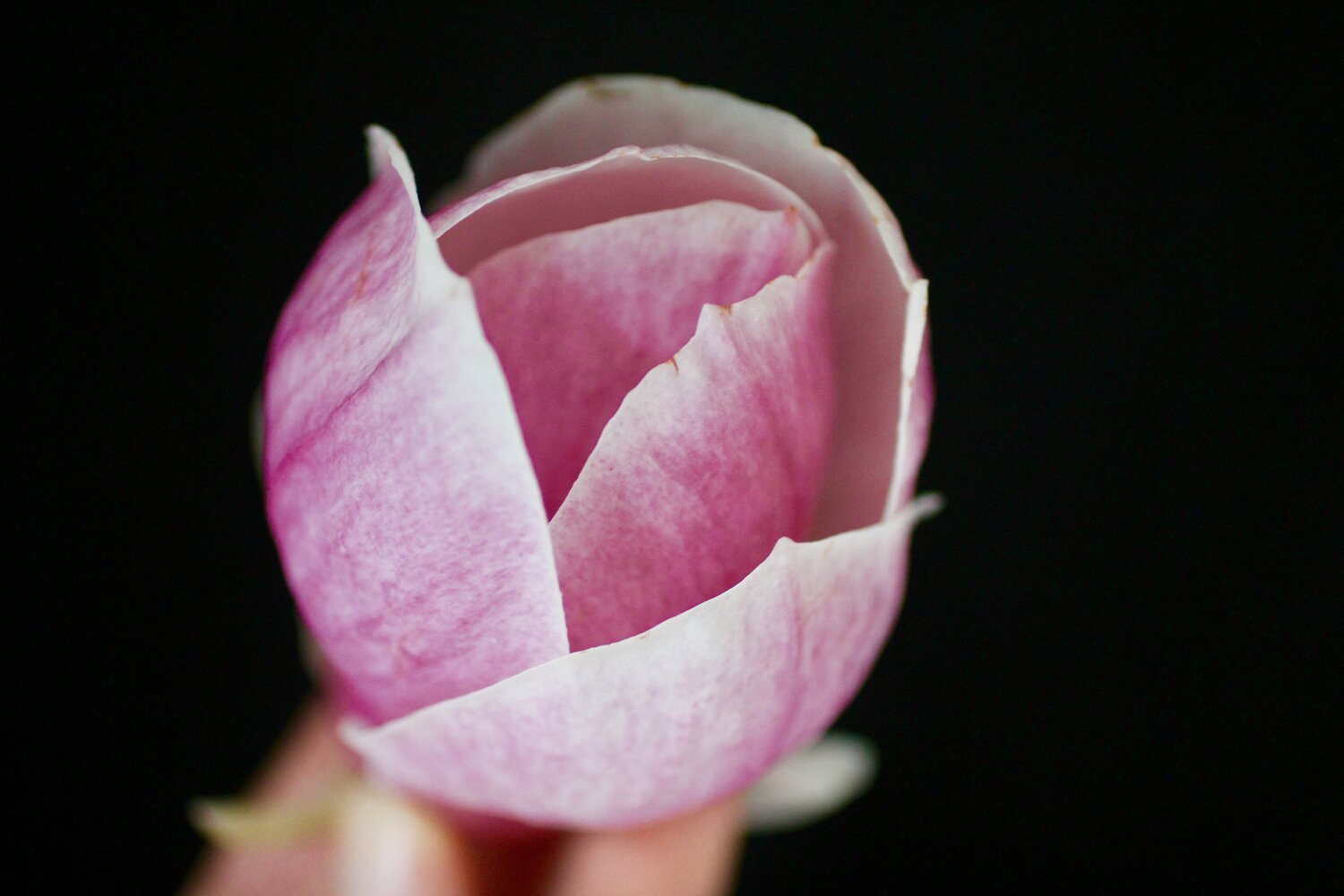Pickled Magnolia Blossoms
Pickled magnolia blossoms
Fresh and pickled magnolia blossoms.
When magnolia trees bloom, they aren’t shy about it - they burst forth in seductive, fragrant glory and leave a slew of thick, oxidizing, hard-to-clean-up flowers in their wake. I love them for this and was pleasantly surprised to find out that the blossoms are also edible. Let’s be honest, these past two (pandemic) springs has been surreal and anxiety-provoking, so having an excuse to go outside and work on a foraging project is and was definitely appreciated. Most magnolias bloom in the spring and all varieties of Magnolias are edible - star magnolia, saucer magnolia, lily magnolia - you name it. The blossoms have variations in color/flavor/texture, so I’d recommend tasting a sliver and seeing what works best for you. Fresh, they have a texture similar to endive with a spicy/floral flavor.
Uses: Prior to this experiment, I’d only used fresh magnolia petals to top desserts, more for decorative purposes than anything. But, you can also use them in small amounts in salads/grain bowls/etc. or they can be pickled, which is the most common application. I would like to try infusing a liquor with them as well, but haven’t gotten around to that yet! Any time you handle the flowers (if you care at all about their appearance) it’s important to be very careful, as the petals bruise/brown easily.
Gorgeous magnolia blossom - for eating raw, the younger leaves are best.
Pickled Magnolia Blossoms: This recipe is an adaptation/combination of two recipes I found (shoutout Medium and eatweeds.co.uk) along with what seemed like it would work and taste the best to me. You can liken the final product to a strong/very floral pickled ginger (with an appearance/texture to match). As you might guess, they work really great with Japanese/Asian flavors like sesame, soy, and seaweed - I’ve used them in a miso noodle bowl (pictured below) and am looking forward to trying it out in a brown rice/sesame bowl or maybe with some homemade sushi/salmon? I could see pickled magnolia being great in any application where pickled ginger sounds good, but also creamy foods to counter the spicy like a compound butter or mild fresh cheeses. The vinegar can be used as you would use regular vinegar as well - for both petals and vinegar, a little goes a long way. Below recipe makes about 1 cup.
220g magnolia flowers (about 6-7 cups packed) - For pickling, it’s ok to have older leaves. For eating fresh you want the younger nicer leaves.
500mL rice vinegar (about 2-¼ cups) - Other light-bodied vinegars or a combination also works, I see a lot of people use apple cider vinegar, but I wanted the subtlety of the rice vinegar.
110g granulated sugar (about ½ cup)
2 teaspoons Kosher salt
To Prepare
Clean and dry flowers - carefully so you don’t bruise the petals.
Add petals to a quart jar or two pint jars (pack tightly). Naturally, jars should be clean.
Heat vinegar with sugar and salt to simmer and sugar/salt is dissolved, stirring as needing.
Pour hot brine over petals.
Using a clean spoon or other utensil, submerge petals under brine several times as they inevitably rise to the top. Optional: I like to use a clean plastic bag or smaller mason jar with a little water to make sure the petals stay submerged.
Cover with lid, allow to come to room temperature, then refrigerate.
Pickled blossoms are ready in 24 hours and will keep in the refrigerator for 4 months to 1 year (still looking into this as I keep them in my fridge - I know that the color will become browner).
Pickled magnolia blossoms in a bowl of miso-ramen.
Classic Elderflower Cordial & Elderflower berry birthday cake
Bring the spring to any beverage or dessert.

Any search for the culinary uses of elderflower will pull up elderflower cordial. By cooking the flower head in what is essentially a diluted simple syrup, you can pretty easily preserve its fragrance for future use. Which is great, because elderflower is an amazing, special plant that deserves to be savored. The most common way to enjoy elderflower cordial is by using it in cocktails (gin, elderflower, and lemon, is a tasty simple classic) or adding a bit to sparkling wine or even sparkling water for a nice kid-friendly afternoon refreshment. I also love drizzling elderflower cordial over any dessert for a quick and easy way to make that dessert oh-so-special (such as for my huckleberry-elderflower birthday cake below).
Elderflower cordial: Makes about 1 liter.
20 medium elderflower heads (about 2-3'' across)
Grated zest of 2 lemons
Juice of 2 lemons
4 cups water
3.5 cups sugar
Note: Some recipes call for citric acid (about 1 teaspoon for this batch), which helps the cordial keep for longer.

Infusing water with elderflower essence.
Inspect the elderflower heads carefully and remove any insects. Remove flowers from most of stems (especially the large ones), wash by quickly submerging in cold water, and drain. Place the flower heads in a large bowl together with the lemon zest.
Bring water to the boil and pour over the elderflowers and citrus zest. Cover and leave overnight to infuse.
Strain the liquid through cheesecloth and pour into a saucepan. Add the sugar and the lemon juice. Heat gently to dissolve the sugar, then bring to a simmer and cook for 2-3 minutes.
Use a funnel to pour the hot syrup into sterilized bottles and seal with a sterilized cap or cork. Bottles can be sterilized by washing with soapy water then plunging into boiling water for 5 minutes and allowing to air dry.
Allow to cool then store in the refrigerator or freezer. Cordial will keep in the fridge for 2 weeks and in the freezer for 1 year. I like to freeze the cordial in smaller batches so I can use it as needed.
Elderflower-Mulberry Birthday Cake: Serves 12.

Bottom half of the cake has been drizzled with cordial and is about to be spread with tart whipped cream.
For my birthday last weekend, I had an inkling to make a cake infused with elderflower cordial, but had a hard time deciding exactly what else to include - apricots and almonds? loquats and honey? lemon and poppyseed? Spring is a fun time to daydream about desserts! While walking through my surprisingly abundant neighborhood however, I was lucky enough to stumble upon some mulberries, which helped to complete my vision. My birthday party was a campout and the cake held up nicely for several hours, even though I was impatient and made the tart whipped cream earlier than necessary:) My photos do not show the final spread of whipped cream on the top, as it was too dark for photos when I added this piece.
1/2 cup plus 5 tablespoons unsalted butter, room temperature
3/4 cup plus 2 tablespoons granulated sugar
4 eggs
2 tablespoons yogurt
3 tablespoons plus up to 3/4 cup elderflower cordial
1 cup all-purpose flour
1/2 cup almond meal
2 teaspoons baking powder
3/4 teaspoons salt
2 cups fresh mulberries, washed and dried
3/4 cup whipping cream
1/2 cup crème fraîche
1/2 teaspoon vanilla extract
Grease a 9-inch springform pan and preheat the oven to 350 degrees F.
Cream the butter and 3/4 cup sugar in a mixer until they’re light and fluffy. Beat in the eggs one at a time then incorporate the yogurt and 3 tablespoons of the elderflower cordial.
In a separate bowl, mix together the flour, almond meal, baking powder, and salt and slowly whisk this into the wet mixture in 3 batches. Once its fully incorporated, pour half of the batter into the greased springform pan, then spread mulberries evenly over the top, followed by remaining batter and bake for 1 hour. Cake is done when a toothpick comes out clean. Remove from oven and allow to cool.
While cake is baking, beat whipping cream until almost stiff, continue beating as you add in 2 tablespoons sugar and vanilla and then lightly whisk in crème fraîche.

The gorgeous mulberry layer is revealed!
Once cake has cooled, cut in half to make two layers using a large serrated knife. You should be cutting right through the berry layer and at this point, you will be able to see all of the beautiful mulberries hiding inside.
Drizzle up to 1/4 cup of elderflower over the bottom layer and top with half of the tart whipped cream, followed by the other half of the cake. Drizzle up to another 1/4 cup of elderflower (for both of these, it depends on how sweet/moist/elderflowery you want the cake) and spread the other half of the whipped cream over the top. Top with a sprinkling of fresh elderflowers if you have them and drizzle each piece of cake with a little more elderflower cordial before eating.

This version is before the addition of the final tart whipped cream layer.










